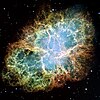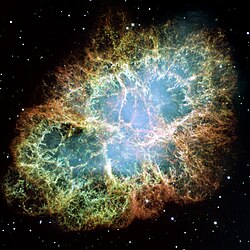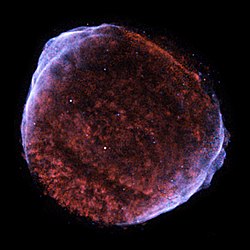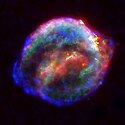Lista över supernovarester
Detta är en lista över observerade supernovarester.
| Bild | Supernova | Tidpunkt så supernovans ljus nått Jorden | Skenbar magnitud av supernovan | Avstånd i ljusår | Typ | Supernovarest |
|---|---|---|---|---|---|---|
 | Sagittarius A:s östra del | ? | ? | 26 000 | ? | Sagittarius A:s östra del |
| Simeis 147 | ~38000 f.Kr. | ? | 3 000 | ? | Simeis 147 eller Sharpless 2-240 | |
 | W49B | ? | ? | 35 000 | ? | GRB-rest? |
 | W50 | ? | ? | 16 000 | ? | SS 433 |
| Seglets supernova | 10000-talet f.Kr.–8000-talet f.Kr. | ? | 800 | ? | Seglets supernovarest | |
 | Slöjnebulosan | >3600 f.Kr. | ? | 1 400–2 600 | ? | NGC 6960, 6974, 6979, 6992 och 6995 |
 | Puppis A | ~1700 f.Kr. | ? | 7 000 approx | ? | |
| G306.3-0.9[1] | 400 f.Kr. | ? | 26 000 approx. | ? | G306.3-0.9 | |
| SN 185 | 7 december 185 | ? | 8 200? | Ia? | Möjligen RCW 86 | |
| EO102 | första årtusendet | ? | 190 000 | ? | EO102 | |
 | SN 1006 | 1 maj 1006 | −7.5 | 7 200 | Ia[2] | SNR 1006 |
 | SN 1054 | 1054 | −6 | 6 300 | II | Krabbnebulosan |
 | G350.1-0.3 | ungefär 1100 | ? | 15 000 approx. | ? | G350.1-0.3 |
 | SN 1181 | 1181 | −1 | minst 26 000 | ? | Möjligen 3C58 |
| RX J0852.0-4622 | ungefär 1250 | ? | 700 | ? | G266.2−1.2 | |
 | SN 1572 | 11 november 1572 | −4 | 7 500 | Ia[2] | Tychos supernovarest |
 | Keplers stjärna | 8 oktober 1604 | −2.5 | 20 000 | [Ia | Keplers supernovarest |
 | Cassiopeia A | mitten av 1600-talet | +6 | 10 000 | IIb[3] | Cassiopeia A |
| G1.9+0.3 | ungefär 1868 | ? | 25 000 approx. | Ia? | SNR G1.9+0.3 | |
| SN 1885A | 20 augusti 1885 | +6 | 2 500 000 | ? | SNR 1885A | |
(c) ESA/Hubble, CC BY 4.0 | SN 1987A | 24 februari 1987 | +3 | 168 000 | II-P | SNR 1987A |
| G033.6+00.1 | 13,000–1,000 f.Kr. | ? | 23 150 [4] | ? | SNR G033.6+00.1 (Kesteven 79) |
Se även
Källor
- Den här artikeln är helt eller delvis baserad på material från engelskspråkiga Wikipedia, List of supernova remnants, 16 november 2014.
- ^ Francis, Reddy. ”NASA's Swift, Chandra Explore a Youthful 'Star Wreck'”. NASA. http://www.nasa.gov/mission_pages/swift/bursts/star-wreck.html. Läst 21 mars 2013.
- ^ [a b] Schaefer, B. E.; Edited by Höflich, Peter; Kumar, Pawan; Wheeler, J. Craig (2004). Cosmic explosions in three dimensions : asymmetries in supernovae and gamma-ray bursts. Cambridge Contemporary Astrophysics. sid. 383. ISBN 0-521-84286-7. http://www.cambridge.org/series/sSeries.asp?code=CCA. Supernovae types discussed in contributed article "Types for the galactic supernovae" by B.E. Schaefer, pages 81–84.
- ^ Krause, Oliver; Birkmann, Stephan M.; Usuda, Tomonori; Hattori, Takashi; Goto, Miwa; Rieke, George H. (2008-05-30). ”The Cassiopeia A Supernova Was of Type IIb” (på engelska). Science 320 (5880): sid. 1195–1197. doi:. ISSN 0036-8075. https://www.science.org/doi/10.1126/science.1155788. Läst 28 augusti 2022.
- ^ ”G033.6+00.1”. http://www.physics.umanitoba.ca/snr/SNRcat/SNRrecord.php?id=G033.6p00.1.A census of high-energy observations of Galactic supernova remnants.
Media som används på denna webbplats
This is a mosaic image, one of the largest ever taken by NASA's Hubble Space Telescope, of the Crab Nebula, a six-light-year-wide expanding remnant of a star's supernova explosion. Japanese and Chinese astronomers recorded this violent event in 1054 CE.
The orange filaments are the tattered remains of the star and consist mostly of hydrogen. The rapidly spinning neutron star embedded in the center of the nebula is the dynamo powering the nebula's eerie interior bluish glow. The blue light comes from electrons whirling at nearly the speed of light around magnetic field lines from the neutron star. The neutron star, like a lighthouse, ejects twin beams of radiation that appear to pulse 30 times a second due to the neutron star's rotation. A neutron star is the crushed ultra-dense core of the exploded star.
The Crab Nebula derived its name from its appearance in a drawing made by Irish astronomer Lord Rosse in 1844, using a 36-inch telescope. When viewed by Hubble, as well as by large ground-based telescopes such as the European Southern Observatory's Very Large Telescope, the Crab Nebula takes on a more detailed appearance that yields clues into the spectacular demise of a star, 6,500 light-years away.
The newly composed image was assembled from 24 individual Wide Field and Planetary Camera 2 exposures taken in October 1999, January 2000, and December 2000. The colors in the image indicate the different elements that were expelled during the explosion. Blue in the filaments in the outer part of the nebula represents neutral oxygen, green is singly-ionized sulfur, and red indicates doubly-ionized oxygen.Tour of E0102.
The Chandra three-color image (inset) of a region of the supernova remnant Puppis A (wide-angle view from ROSAT in blue) reveals a cloud being torn apart by a shock wave produced in a supernova explosion. This is the first X-ray identification of such a process in an advanced phase. In the inset, the blue vertical bar and the blue fuzzy ball or cap to the right show how the cloud has been spread out into an oval-shaped structure that is almost empty in the center. The Chandra data also provides information on the temperature in and around the cloud, with blue representing higher temperature gas. The oval structure strongly resembles those seen on much smaller size scales in experimental simulations of the interaction of supernova shock waves with dense interstellar clouds (see sequence of laboratory images). In these experiments, a strong shock wave sweeps over a vaporized copper ball that has a diameter roughly equal to a human hair. The cloud is compressed, and then expands in about 40 nanoseconds to form an oval bar and cap structure much like that seen in Puppis A.
Författare/Upphovsman: Jschulman555, Licens: CC BY 3.0
Witch's Broom region of Veil Nebula. 24 inch telescope on Mt. Lemmon, AZ.
Tycho's Supernova Remnant. In 1572, the Danish astronomer Tycho Brahe observed and studied the explosion of a star that became known as Tycho's supernova. More than four centuries later, Chandra's image of the supernova remnant shows an expanding bubble of multimillion degree debris (green and red) inside a more rapidly moving shell of extremely high energy electrons (filamentary blue). As a huge ball of exploding plasma, it was Irving Langmuir who coined the name plasma because of its similarity to blood plasma, and Hannes Alfvén who noted its cellular nature. The filamentary blue outer shell of X-ray emitting high-speed electrons is also a characteristic of plasmas. This is a false-colour x-ray image in which the energy levels (in keV) of the x-rays have been assigned colours as follows: Red 0.95-1.26 keV, Green 1.63-2.26 keV, Blue 4.1-6.1 keV. All x-rays images must use processed colours since x-rays (as are radio waves, infra-red) are invisible to the human eye. But they are not invisible to suitable equipment, such as x-ray telescopes. The red and green bands highlight the expanding cloud of plasma with temperatures in the millions of degrees.
(c) ESA/Hubble, CC BY 4.0
1987A supernova remnant near the center. Composite of two public domain NASA images taken from the Hubble Space Telescope. Edited with the GIMP. Uploaded to en:Wiki by en:User:Maveric149, higher resolution version uploaded by en:User:JamesHoadley
Författare/Upphovsman: Smithsonian Institution, Licens: No restrictions
Chandra's false-color image of SN 1006 shows X-rays from multimillion degree gas (red/green) and high-energy electrons (blue). In the year 1006 a "new star" appeared in the sky and in just a few days it became brighter than the planet Venus. We now know that the event heralded not the appearance of a new star, but the cataclysmic death of an old one. It was likely a white dwarf star that had been pulling matter off an orbiting companion star. When the white dwarf mass exceeded the stability limit (known as the Chandrasekhar limit), it exploded. Material ejected in the supernova produced tremendous shock waves that heated gas to millions of degrees and accelerated electrons to extremely high energies.
X-ray, Optical & Infrared Composite of Kepler's Supernova Remnant
"On October 9, 1604, sky watchers -- including astronomer Johannes Kepler, spotted a "new star" in the western sky, rivaling the brilliance of nearby planets. "Kepler's supernova" was the last exploding supernova seen in our Milky Way galaxy. Observers used only their eyes to study it, because the telescope had not yet been invented. Now, astronomers have utilized NASA's three Great Observatories to analyze the supernova remnant in infrared, optical and X-ray light." [1]
- Color Code (Energy):
- Blue: X-ray (4-6 keV), en:Chandra X-ray Observatory, The higher-energy X-rays come primarily from the regions directly behind the shock front.
- Green: X-ray (0.3-1.4 keV), en:Chandra X-ray Observatory; Lower-energy X-rays mark the location of the hot remains of the exploded star.
- Yellow: Optical, en:Hubble Space Telescope; The optical image reveals 10,000 degrees Celsius gas where the supernova shock wave is slamming into the densest regions of surrounding gas.
- Red: Infrared, en:Spitzer space telescope; The infrared image highlights microscopic dust particles swept up and heated by the supernova shock wave.
Image taken with the NASA/ESA Hubble Space Telescope provides a detailed look at the tattered remains of a supernova explosion known as Cassiopeia A (Cas A). It is the youngest known remnant from a supernova explosion in the Milky Way. The new Hubble image shows the complex and intricate structure of the star’s shattered fragments.
Chandra's image of 3C58, the remains of a supernova, shows a rapidly rotating neutron star embedded in a cloud of high-energy particles. The data revealed that the neutron star, or pulsar, is rotating about 15 times a second, and is slowing down at the rate of about 10 microseconds per year.
Författare/Upphovsman: NRAO/AUI/NSF, K. Golap, M. Goss; NASA’s Wide Field Survey Explorer (WISE), Licens: CC BY 3.0
Radio image of supernova remnant W50 in green, with infrared background in red.
The remnant, called W49B, is about a thousand years old, as seen from Earth, and is at a distance of about 26,000 light years away. The highly distorted supernova remnant shown in this image may contain the most recent black hole formed in the Milky Way galaxy. The image combines X-rays from NASA's Chandra X-ray Observatory in blue and green, radio data from the NSF's Very Large Array in pink, and infrared data from Caltech's Palomar Observatory in yellow.
This Chandra image of Sgr A* and the surrounding region is based on data from a series of observations lasting a total of about one million seconds, or almost two weeks. Such a deep observation has given scientists an unprecedented view of the supernova remnant near Sgr A* (known as Sgr A East) and the lobes of hot gas extending for a dozen light years on either side of the black hole. These lobes provide evidence for powerful eruptions occurring several times over the last ten thousand years. The image also contains several mysterious X-ray filaments, some of which may be huge magnetic structures interacting with streams of energetic electrons produced by rapidly spinning neutron stars. Such features are known as pulsar wind nebulas.
Supernova remnants G350.1-0.3














